Mastering the Waves: Your Guide to Surfing Essentials
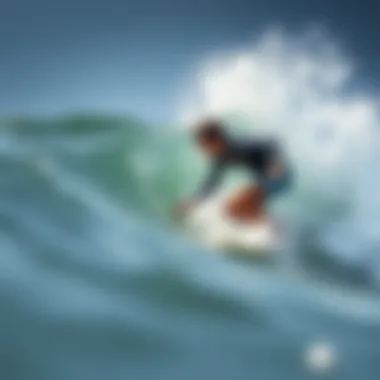
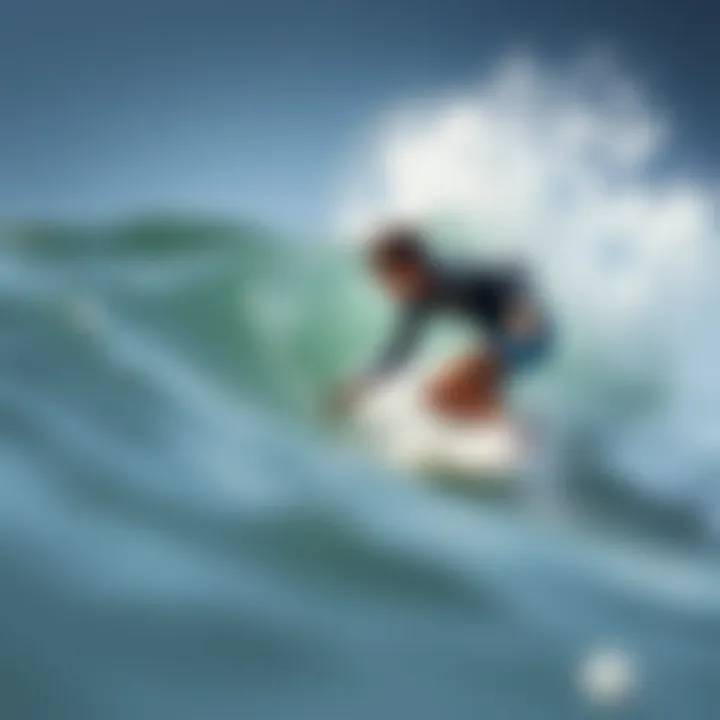
Intro
Learning to ride the waves offers a unique blend of thrill and tranquility that few activities can replicate. Surfing, in particular, cuts across generations and cultures, establishing a deep connection between individuals and the ocean. Not everyone realizes that the journey to mastering the art of surfing is not merely about paddling out and catching a wave; it involves understanding the ocean's whims, the intricacies of the surfboard, and crucially, oneself. This guide aims to shed light on the essential insights every aquatic enthusiast should know, from novices looking to dip their toes in the water to seasoned surfers aiming to refine their technique.
Surfing transcends just being a sport; it is a lifestyle embraced by many. This article will navigate through the fundamental skills and techniques necessary for success in the surf, emphasizing safety measures and equipment selection to ensure an enjoyable experience. We will help you learn how to choose the right surf school, comprehend the ever-changing ocean conditions, and cultivate the mental fortitude required to ride those relentless waves. Through a balance of physical preparation and mental readiness, the beauty and exhilaration of surfing become far more attainable. Let's dive deeper into the waves and explore the various tips and techniques that can cement your surfing journey's foundation.
Tips and Techniques
Beginner Tips for Watersports
Starting out in surfing can be a bit overwhelming, but a few foundational tips can set you on the right path. Having a stable board and understanding how to balance is crucial. A soft-top surfboard can be forgiving for beginners, offering both buoyancy and stability.
- Choose the Right Waves: Look for smaller, slower waves to start. These give newcomers the chance to practice paddling and balancing without the intimidation of larger swells.
- Learn the Basics of Paddling: Mastering how to paddle efficiently will allow you to position yourself properly in the lineup for catching waves.
- Practice Balance: Spend time standing on your board in shallow water. This helps you get a feel for how your weight shifts in response to the wave and begins to establish muscle memory.
- Study Surf Etiquette: Understanding the rules of the water will not only help you avoid conflicts but will also enhance your overall surfing experience. Respecting others in the water is as crucial as mastering your own skills.
Advanced Techniques for Mastery
For those who have grasped the basics and want to push their skills further, there are numerous advanced techniques worth mastering.
- Carving Turns: This involves shifting your weight to your heels or toes to maneuver your board in a fluid motion down the line.
- Duck Diving: A valuable technique for getting under waves while paddling out. When executed correctly, this will save you energy and keep you in the zone.
- Aerials: Once you have your carving down, introducing aerials can elevate your surfing to a new level. They require good timing and a solid technique, so ensure you’re ready before attempting.
"Surfing is not just an activity; it's about finding your rhythm with the ocean and your board."
Staying consistent with practice and seeking feedback from more experienced surfers can significantly facilitate your progress. Learning from both triumphs and mistakes is a part of the exhilarating journey of surfing, where every wave brings its lesson.
Safety and Gear
Essential Safety Practices
Diving into the surf without proper precautions is inviting trouble. Safety mustn't be overlooked.
- Always Wear a Leash: This simple piece of equipment keeps your board attached to you, preventing it from getting swept away and hurting others.
- Know Your Limits: Surfing in conditions beyond your skill level can lead to unnecessary risks. Start with manageable waves and gradually progress.
- Stay Aware of Local Hazards: Shore breaks, rip currents, and rocks can pose significant threats. Familiarize yourself with the surf zone before you enter it.
Gear Reviews and Recommendations
Selecting the suitable gear can make or break your surfing experience. Here are some recommendations:
- Surfboard: For beginners, a longer, wider board is generally easier to handle. Brands like Softlite or Wavestorm offer durable soft-top boards perfect for newcomers.
- Wetsuit: Depending on the local climate, a good wetsuit is essential for warmth and comfort. O'Neill offers reliable options with varying thicknesses suitable for different water temperatures.
- Sun Protection: Sunscreen specifically designed for water sports is pivotal. Look for brands such as ZINC which provide effective protection with a water-resistant formula.
Becoming proficient in surfing involves more than just physical practice; it encompasses mental awareness and respect for the elements at play. Whether you're just dipping your toes in or looking for ways to refine your skills, this guide equips you with the essential insights you need to embark on a fulfilling surfing journey.
Understanding Surfing
Surfing is not just a sport; it's a lifestyle and a connection to the ocean that transcends mere recreational activity. For anyone looking to dip their toes into this aquatic world, understanding the fundamentals of surfing is of utmost importance. Grasping the essence of surfing equips aspiring surfers with knowledge about the sport's history, techniques, and safety, enriching their overall experience on the waves.
An Overview of Surfing
Surfing, simply put, involves riding on the surface of waves using a surfboard. Whether it’s the thrill of catching a wave or the serenity of floating amidst the vast ocean, surfing delivers a unique experience. It’s not confined just to the beach; surfing can also be a community, a form of self-expression, and a way to foster connection with nature. For many, it marks the beginning of a lifelong passion, intertwined with personal growth and exploration.
The Origins and Evolution of Surfing
The origins of surfing date back to ancient Polynesian cultures, where it was deeply rooted in social customs and rituals. Over centuries, the sport evolved significantly, crossing over to mainland America and shaping subcultures on the West Coast during the 20th century. With advancements in technology, surfboards transformed from heavy wooden planks to lightweight foam designs, making the sport more accessible.
Today, surfing is celebrated worldwide. It has melded into various cultures, reflecting values and lifestyles distinct to its region, but always maintaining an intrinsic bond with the ocean. Understanding these roots helps surf enthusiasts appreciate the profound culture behind the sport.
Different Types of Surfing Techniques
To truly engage with surfing, it's essential to recognize the different surfing techniques. Each technique offers unique experiences and caters to various skill levels, influencing how surfers interact with the waves. Here, we’ll delve into a few prominent surfing styles:
Shortboard vs Longboard Surfing
Shortboard and longboard surfing serve different preferences and approaches to riding waves. Shortboarding is characterized by its sleek and agile boards, allowing for rapid turns and aerial maneuvers. This style caters to more experienced surfers who relish the adrenaline of fast-paced rides and technical tricks.
Conversely, longboarding emphasizes fluidity and grace. With longer boards, surfers can incorporate more traditional techniques like noseriding and maintain their balance with ease. Longboarding tends to be a favored choice among those who appreciate a relaxed and stylish approach, making it soundly popular among beginners aiming to polish their footing at the start of their surfing journey.
- Key Characteristic: Flexibility in riding styles and adaptability for different wave conditions makes both boards appealing in their way.
- Advantages and Disadvantages: Shortboards excel in performance and trick capability but require more skill and experience. Longboards, while easier for beginners to handle, may lack speed in powerful conditions.
Tow-In Surfing
Tow-in surfing emerged as a technique designed to conquer bigger waves. Using a personal watercraft, surfers are towed onto waves too large to paddle into. This method drastically expands the possibilities for hardcore wave riders, enabling them to tackle formidable breaks around the globe.
- Key Characteristic: This technique demands a team effort, often involving a partner on the jet ski.
- Advantages and Disadvantages: While it grants access to extraordinary waves, it necessitates proficiency in both surfing and teamwork, making it less suited for beginners.
Stand-Up Paddle Boarding
Stand-up paddle boarding (SUP) has surged in popularity, known for its versatility. It combines the serenity of paddling with the thrill of surfing, allowing enthusiasts to explore scenic coastlines and serene waters. While it isn't traditional surfing in the purest sense, SUP can be done on waves, bridging the gap for both surfers and kayakers alike.
- Key Characteristic: SUP offers stability and ease, making it accessible for all skill levels, and can often be enjoyed in calmer waters, drawing in a diverse crowd.
- Advantages and Disadvantages: It’s user-friendly for beginners; however, some avid surfers may find it lacks the thrill of traditional wave riding.
Understanding these particular nuances of surfing techniques not only enhances respect for the sport but also helps fine-tune an individual’s surfing style, making the journey into surfing multidimensional.
Preparing to Surf
Getting ready to surf isn't just about grabbing a board and hitting the waves. It’s a critical phase that lays the groundwork for a successful surfing journey. This section will focus on the essential elements that one must consider when preparing to surf, highlighting the benefits and important details that can ensure a smoother and more enjoyable experience in the water.


Choosing the Right Surfboard
Board Length and Shape
The length and shape of a surfboard can make a world of difference in your surfing proficiency. For beginners, opting for a longer board can enhance stability. Generally, boards longer than 8 feet provide a bigger surface area, making it easier to paddle and stand up. The rounded nose shapes are particularly advantageous for beginners as they help in catching waves with more ease. Shortboards, while faster and more agile in the water, can be quite challenging and are often not the best choice for novices.
- Key Characteristic: Stability in longer boards
- Benefits: Easier for paddling and learning to balance
- Disadvantages: Shortboards may limit beginners due to their smaller area, which makes balance tough during the learning phase.
Material Options
Material choice is pivotal in determining how a surfboard performs and how comfortable it feels. Fiberglass boards, for example, offer excellent durability and performance. Meanwhile, foam boards are lighter and forgiving, making them a great option for those just starting. They are also less likely to cause injury due to their softer material. Choosing the right material plays a significant role in how one experiences surfing.
- Key Characteristic: Durability and performance from fiberglass
- Benefits: Foam boards offer safety for learners
- Disadvantages: Fiberglass can be heavier and less forgiving for beginners compared to foam.
Design Considerations for Beginners
When selecting a surfboard design, there are a few factors you need to wrap your head around. Thickness, volume, and rocker are all key. A thicker board helps a surfer float better, which is vital for beginners who are still mastering the art of balance. A minimal rocker—how curved the board is—can be beneficial too, as it provides a flatter surface for catching waves.
- Key Characteristic: Enhanced buoyancy and stability
- Benefits: Increased chances of catching waves
- Disadvantages: More specialized designs can be confusing for newcomers without proper guidance.
Essential Surfing Gear
Wetsuits and Their Importance
Wetsuits are more than just a fashion statement on the beach; they're essential for warmth and protection. Depending on water temperature, a suitable wetsuit keeps one's body temperature regulated, allowing longer sessions in the water, especially in colder climates. The right wetsuit also protects against abrasions from a surfboard and potential stings from marine life.
- Key Characteristic: Insulation and protection
- Benefits: Extended surf time without the discomfort of cold water
- Disadvantages: Can be expensive and might feel restrictive until one gets used to it.
Leashes and Fins
A leash is vital for safety. It keeps the surfboard tethered to the surfer while preventing the board from becoming a hazard to others in the water. Various fin setups can affect how a board turns and rides. Beginner surfers may find a thruster-fin setup more forgiving, giving added control and stability, which helps immensely when learning how to maneuver.
- Key Characteristic: Safety and control in the water
- Benefits: Minimizes the chance of losing the board
- Disadvantages: Improperly fitted leashes can snap or become a liability.
Surf Accessories
Besides the basics, accessories can enhance the surfing experience. Traction pads can give surfers better grip on their boards, which is especially helpful for performing maneuvers. Surf wax prevents slipping and is indispensable for maintaining grip on the board. Having such accessories can significantly reduce the learning curve for new surfers.
- Key Characteristic: Enhanced grip and control
- Benefits: Reduces the risk of falls due to slipping
- Disadvantages: Can add additional cost and complexity to basic surfing gear.
Selecting a Surf School
Credentials and Experience of Instructors
When looking to learn surfing, the credentials and experience of instructors should be taken seriously. Experienced instructors can offer invaluable insights, tips, and corrections to help students progress more quickly. A qualified instructor often holds certifications from recognized bodies, assuring that they meet certain standards in teaching safety and technique.
- Key Characteristic: Professional guidance
- Benefits: Enhanced learning experience and safety awareness
- Disadvantages: May cost more than informal options.
Reviews from Previous Students
Checking reviews from former students can provide insight into what one can expect from a surf school. Honest feedback can reveal instructors' teaching styles, the quality of the facilities, and the overall atmosphere at the school. This kind of research is crucial in making an informed choice that aligns with personal learning preferences.
- Key Characteristic: Peer feedback for informed decision-making
- Benefits: Helps avoid subpar experiences
- Disadvantages: Reviews can sometimes be subjective and vary widely.
Location and Facility Quality
Lastly, the quality of the surf school's facilities and its location cannot be overlooked. A school located near popular surf spots can provide fresh and challenging conditions suited for learning. Essential amenities like changing rooms, showers, and surfboard rentals contribute significantly to overall comfort and convenience.
- Key Characteristic: Accessibility and convenience
- Benefits: Aids in creating a more enjoyable learning environment
- Disadvantages: Top-tier locations can be busier, leading to less personalized attention.
Ensuring you are well-prepared before your first wave can mark the difference between a thrilling adventure and a frustrating experience. By carefully considering your equipment, gear, and instructors, you set the stage for a rewarding journey into the world of surfing.
Learning the Basics
Learning to surf is like picking up a new language; it carries the weight of technique, understanding, and respect for nature. It's not just about strapping on a surfboard and hitting the waves. You'll witness the connection between the rider and the ocean, the balance of body and mind aboard that board. Understanding the basics serves as the bedrock for mastering more complex maneuvers. It’s essential for newcomers to grasp these fundamentals since they shape an individual’s skill, safety, and overall surfing experience.
Fundamental Surfing Techniques
Paddling Strategies
Paddling effectively can make or break a surfer's experience. Think of paddling as the engine of your surf journey; without it, you're just floating. Key to this technique is the efficiency of movement and body position. A well-executed paddle helps in catching waves, controlling speed, and navigating through water. A focused and rhythmic stroke improves endurance, making it a popular choice among both beginners and advanced surfers.
A unique feature of paddling strategies is the emphasis on core strength. Engaging your core not only stabilizes your body but also enhances your power when pushing through the water. However, a downside might be the initial physical fatigue, as some might struggle to find that ideal positioning and rhythm when starting.
Positioning on the Board
How and where you place yourself on the board directly impacts your ride. Positioning refers to the balance you maintain while lying on the surfboard, and getting it right is crucial for success. If too far back or too far forward, you risk a wipeout before ever catching a wave. The key characteristic here is balance. Achieving a balanced position leads to a smooth take-off and enhances the flow while riding. This is essential as it allows you to feel the wave's energy beneath you.
An interesting aspect is knowing when to shift weight forward or backward to adjust speed and responsiveness during a ride. The major challenge, though, arises in learning to read the wave’s energy while adjusting your position—this can take some trial and error for new surfers.
Standing Up on the Wave
Finally, the moment of standing up on the wave, often termed "pop-up", is like the pièce de résistance of your surfing journey. It represents the transition from a beginner to an actual surfer. In surfing, standing up involves quickly shifting your body from a prone position to an upright stance. It’s often regarded as one of the most rewarding experiences.
The unique part of this skill is the timing involved. Catch the wave at just the right moment, and you’ll feel that rush. Yet, the challenge is that it demands coordination and muscle memory, which can be tricky when starting out.
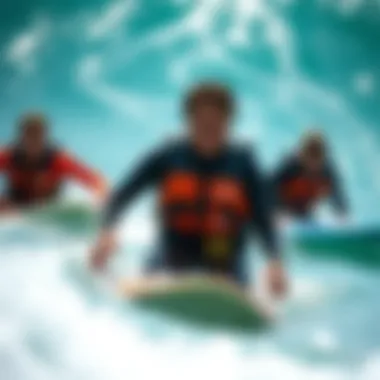
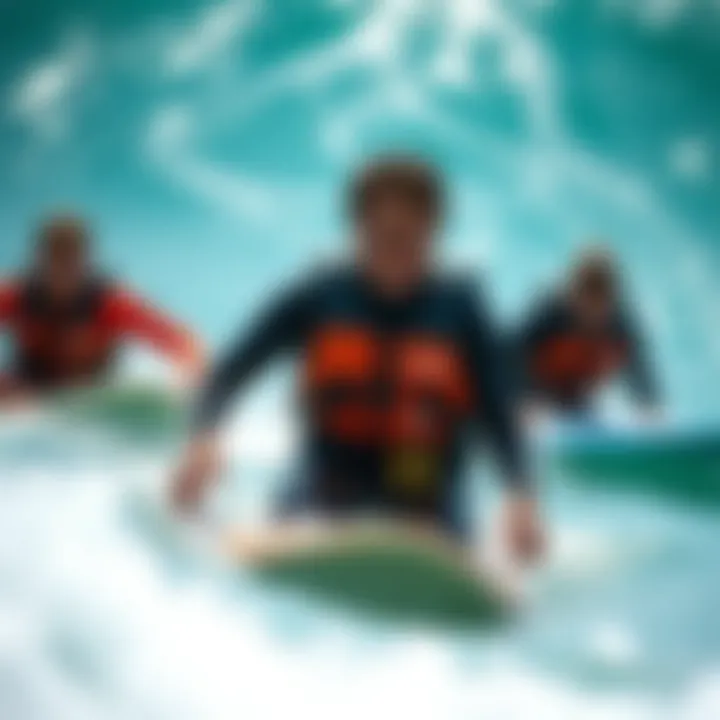
Understanding Ocean Conditions
Reading Waves
Reading waves is analogous to understanding the rhythm of a dance. Knowing how waves form, peak, and break is crucial for any surfer. This skill helps surfers choose the right waves to ride, which ultimately impacts their experience and progression in surfing. A key feature of this skill is recognizing different types of wave breaks: reef, point, or beach breaks. Each presents unique opportunities and challenges, influencing your surf strategy.
An advantage of mastering wave reading is the confidence boost it provides. Surfers who can read waves tend to be safer and make better decisions in the water. However, it requires practice and experience, which may be daunting initially.
Tides and Currents
Understanding tides and currents is like knowing the rules of a game before diving in. Tides affect wave behavior significantly. High tides can create different surf experiences compared to low tides, which can expose reefs and other obstacles. Key to this is learning how to read tide charts and how they influence your local waves—this is crucial for ensuring safety and optimal surfing conditions.
A unique aspect here is the effect of rip currents. While they can be menacing, knowing their patterns can safely guide you back. The downside remains that tides can shift unexpectedly, catching unprepared surfers off guard.
Weather Factors Impacting Surfing
Surfing is deeply influenced by weather conditions, often dictating the best times to hit the water. Understanding how wind direction and speed can shape wave quality is pivotal for any surfer. This highlights the key characteristic of being proactive in checking forecasts before heading out to surf.
The unique feature here lies in local weather patterns—each surf spot has its distinctive wind and weather influence. The downside is that predictions can be unpredictable, and an experienced surfer should be adaptable to sudden changes in conditions.
"Surfing teaches you to respect Mother Nature and to adapt to her ever-changing whims."
Ultimately, learning the basics of surfing equips you with the critical tools necessary to not just survive, but to thrive in the aquatic world.
Safety Tips for Surfers
Surfing is an exhilarating activity, but it comes with its fair share of risks. That's why safety tips are crucial for surfers at any level. By understanding the hazards and equipping yourself with the right knowledge and tools, you can enjoy the ocean while keeping danger at bay. This section will delve into critical aspects of surfer safety, focusing on recognizing hazardous conditions and essential safety equipment that every surfer should have.
Recognizing Hazardous Conditions
Rip Currents
Rip currents, powerful channels of water flowing away from the shore, pose a significant threat to surfers. These currents can be deceptively strong and can sweep even the most experienced surfers out to sea. Understanding the characteristics of rip currents can help surfers recognize them and avoid dangerous situations.
A key feature of rip currents is their often narrow appearance, seeming like a break in the wave pattern. This visual cue is vital, as it may not be evident how rapidly the current can pull someone away from the shore. Once a surfer comprehends how to identify rip currents, they can use this knowledge to either avoid them or navigate safely through them should the need arise.
The takeaway here is that awareness of rip currents not only helps prevent accidents but also enhances your overall enjoyment of surfing.
Marine Life Awareness
Being conscious of marine life is another critical safety consideration for surfers. Understanding the types of creatures you may encounter, such as jellyfish or sharks, is essential to mitigate risks and enjoy the surf.
A well-rounded surfer should study common local marine species and their behavior. Some marine animals, like jellyfish, thrive in warm waters and can present a serious sting, while others, such as sharks, generally avoid human interactions but pose a potential risk. Knowing how to observe these species from a safe distance can lead to a much more pleasant experience in the water.
Unique features of marine awareness include the fact that it encourages respect for nature and fosters a deeper relationship between surfers and the ocean. It can also lead to more informed decisions regarding when and where to surf based on marine activity.
Weather and Visibility Issues
Understanding weather patterns and visibility conditions is imperative for surfer safety. Sudden storms can create unpredictable waves and strong winds, making conditions treacherous. Moreover, water visibility can drastically change depending on weather, affecting a surfer's awareness of their surroundings.
For instance, cloudy weather may obscure visibility under the water, while bright, sunny conditions can create glare on the surface. Surfers should keep an eye on weather forecasts and be prepared for sudden changes. Entering the water with poor visibility increases the risk of accidents, such as collisions with other surfers or obstacles.
In this case, the ability to discern safe from unsafe conditions greatly contributes to a surfer's overall safety and experience on the water.
Essential Safety Equipment
Personal Flotation Devices
Personal flotation devices (PFDs) can be lifesavers for surfers, especially beginners. While many surfers may feel confident about their swimming ability, unexpected circumstances like rip currents or fatigue can arise. A well-fitted PFD can keep you afloat, giving you a better chance of calling for help or swimming back to safety.
The key aspect of a PFD is its buoyancy, designed to keep a person above water. This feature is particularly beneficial for those who may struggle with their swimming skills or are new to surfing. It's crucial for any surfer to understand that while PFDs may not be the norm in all surf settings, they can significantly enhance safety.
Emergency Signals
Knowledge of emergency signals is vital for effective communication in the water. If a surfer finds themselves in a precarious situation, being able to signal for help can make all the difference. This can include simple hand signals or specific behaviors, like waving your arms to attract attention.
The uniqueness of knowing these signals is that they can provide peace of mind. Rather than panicking, surfers can communicate effectively with lifeguards or fellow surfers, improving their chances of swift rescue. Furthermore, understanding how to respond to someone in distress can foster a more supportive surfing community.
First Aid Kits
A comprehensive first aid kit is an essential part of a surfer's gear. Accidents are sometimes unavoidable, and having a kit at hand can provide immediate relief for minor injuries, such as scrapes and cuts, which are commonplace in the sport of surfing.
First aid kits should include basic supplies like band-aids, antiseptics, and gauze. Their advantage lies in their preparedness for unexpected scenarios. By being equipped with a first aid kit, surfers can take immediate care of an injury, reducing the risk of infection and ensuring a quicker return to surfing.
"The ocean can be unpredictable; safety should never be an afterthought."
Physical and Mental Preparation
Physical and mental preparation is the backbone of a successful surfing experience. Many novice surfers jump into the water without understanding that the sport requires significant physical capacity and mental agility. A strong body aids in paddling, balance, and maneuverability, while a sharp mind fosters quick decision-making and resilience against unexpected challenges in the waves.
Being fit can make a world of difference in how you navigate the surf. While some may think it's just about staying afloat, there’s a lot more to it. Proper conditioning not only helps you avoid injuries but also enhances your overall performance. Likewise, having a calm and resilient mindset allows you to face the many trials that surfing presents—from managing fear to overcoming the anxiety that often comes with catching waves.
To give you a leg-up, let’s break down how you can physically train and mentally prepare yourself for the waves ahead.
Fitness Regimens for Surfers
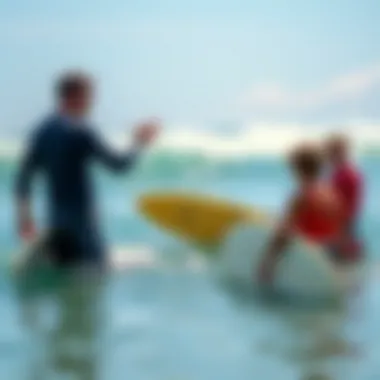
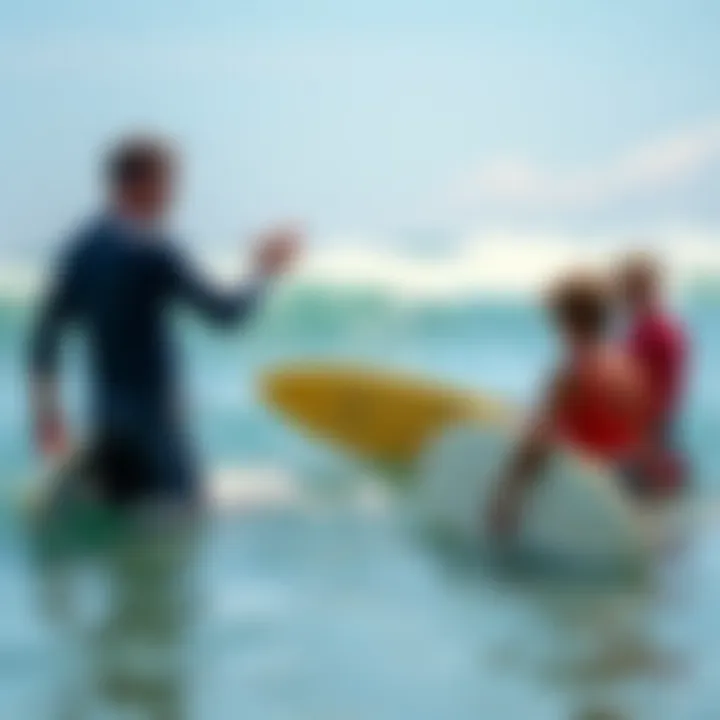
Training systems tailored for surfers is crucial to building a robust surf foundation. These regimens usually encompass three main elements: strength training, endurance exercises, and flexibility routines. Each contributes to your capability in the water in unique ways.
Strength Training
Strength training focuses primarily on building muscle power, which is essential for paddling and positioning yourself on the board. Key characteristic of strength training is that it develops functional muscles used specifically in surfing. Using weights, resistance bands, or even bodyweight exercises, like push-ups and squats, helps build the muscles you need to push through the waves.
One unique feature of strength training is how it allows you to adapt your regimen based on personal goals—whether to enhance endurance through lighter weights or heighten power with heavier lifts. A well-structured strength program can enhance your balance and stability on the surfboard, a fundamental aspect of riding a wave successfully. However, it’s pivotal to not overdo it; excessive strength without proper technique can lead to injuries.
Endurance Exercises
Endurance exercises are designed to enhance your cardiovascular fitness, allowing you to paddle longer without tiring. A surfer needs stamina to withstand the physical exertion of catching waves and returning to the line-up continuously.
The typical formats for endurance training include steady-state activities like jogging, swimming, or cycling. What sets endurance exercises apart is their ability to condition the body for long periods of exertion which is vital for anyone wanting to spend hours in the water. While these can be physically demanding, proper pacing and a consistent schedule help develop lasting endurance without leading to burnout.
Flexibility Routines
Flexibility routines, often overlooked, play a significant role in surfing. They help avoid injuries and improve your range of motion, crucial for performing various maneuvers on a board. The key characteristic is that they increase your body’s elasticity, critical when you’re trying to twist into a maneuver or adjust mid-ride.
Unique features of these routines include dynamic stretching before activities and static stretching afterward. Enhanced flexibility not only makes it easier to maintain balance on your board, but can also shorten recovery time after intense activities. That said, too much emphasis on flexibility with no balance of strength can lead to instability.
Mental Resilience in Surfing
Mental resilience is just as important as physical fitness in the surfing world. The ability to stay composed under pressure can often dictate whether you successfully ride a wave or wipe out. Training your mind can be as critical as beefing up your core strength or working your quads.
Visualizing Success
Visualizing success involves imagining yourself performing well in the water. It’s a technique used by countless athletes across various sports, and for good reason. The key characteristic is that it allows you to create a mental blueprint of optimum performance, which enhances your chances of successfully executing difficult maneuvers.
By picturing your best surf outings, you condition your mind to recognize possibilities and boosts your confidence. However, it’s essential to balance visualization with actual practice—spending too much time dreaming without doing can lead to unreal expectations.
Overcoming Fear and Anxiety
Fear and anxiety are natural human emotions that many surfers face, especially beginners. Addressing these feelings head-on can make a significant difference in your surfing experience. The key characteristic of overcoming fear involves recognizing it and employing strategies to mitigate its effects.
This could be as simple as breathing techniques or setting small, achievable goals. The unique aspect is that each surfer’s fear might stem from different sources, whether related to lack of experience or specific conditions in the water. By systematically tackling these fears, surfers can gradually build their confidence and improve overall performance.
Building Confidence in the Water
Lastly, building confidence in the water is an ongoing process that requires consistent practice and patience. The more time spent on the waves, the more skilled and confident you become. A key characteristic is that confidence grows from experience, lesson by lesson, wipeout by wipeout.
One must not underestimate the power of support from fellow surfers, mentors, or coaches, as they can provide encouragement and constructive feedback. However, confidence can wane after a tough session and may require additional focus to restore. Hence, striking a balance between pushing boundaries and respecting limits is essential for sustained growth in surfing.
Surfing Culture and Community
Surfing is much more than just a sport; it's a vibrant lifestyle woven into the fabric of coastal towns and communities around the globe. Understanding the culture and community surrounding surfing is crucial for both newcomers and seasoned surfers alike. Not only does it shape their experiences in the water, but it also fosters a unique sense of belonging among enthusiasts. This section navigates through the heart of surfing culture—how it brings people together and encourages sustainable practices for the benefit of our planet.
The Global Surfing Community
The global surfing community is a tapestry of diverse individuals passionate about waves and the ocean. Surfers from different backgrounds unite through their shared love for riding the waves.
Famous Surfing Competitions
Famous competitions like the World Surf League (WSL) Championship Tour elevate the sport, featuring top surfers battling it out for glory. These competitions not only showcase athletic prowess but also embody the spirit of camaraderie, as surfers bond over shared experiences. One key characteristic of these events is their global footprint—tours occur in picturesque locations worldwide, from Hawaii's North Shore to Portugal's surf breaks.
The benefits of participating in such competitions include heightened visibility for the sport and the opportunity for surfers to gain sponsorships and recognition. However, the pressure of competition can also bring drawbacks, like stress and the relentless pursuit of perfection.
Influential Surfers in History
Throughout history, influential surfers such as Duke Kahanamoku and Kelly Slater have significantly shaped the surfing landscape. Their contributions not only advanced surfing techniques but also championed the sport on worldwide stages. Characters like Duke popularized surfing beyond Hawaii, introducing it to the mainland and even the Olympics.
One standout feature of these figures is their ability to inspire future generations. They’ve empowered young surfers to dream big while also raising awareness about ocean conservation. The downside? Sometimes, the focus on individual achievements can overshadow the community aspect of surfing.
Surfing as a Lifestyle
To many, surfing represents a lifestyle choice—it’s about more than just enjoying the waves; it’s a state of mind. Surfers often adopt a laid-back attitude, embracing the unpredictability of the ocean. Their day-to-day lives reflect this philosophy, focusing on balanced living and environmental responsibility. By fostering connections with fellow surfers, individuals find support and encouragement, creating lasting friendships.
This lifestyle is particularly beneficial, as it promotes mental well-being and physical fitness. Yet, one downside to this lifestyle can be the misconception that all surfers are carefree, when in reality, they often face challenges like environmental concerns or sport accessibility.
Sustainable Surfing Practices
With the rising awareness of environmental issues, surfers are now advocating for sustainable practices. Protecting the ocean ensures that future generations can enjoy the waves, and here’s how surfers are making an impact.
Reducing Plastic Waste
A significant aspect of reducing plastic waste revolves around promoting eco-friendly products. Surfers are increasingly turning to reusable gear and sustainable surfboards made from materials like bio-resin. "Every bit helps!" as the saying goes, highlighting that even small actions can combine into a larger wave of change. The big advantage is creating a cleaner ocean for both surfers and marine life.
On the flip side, transitioning to sustainable alternatives can be costly, making it less accessible for some surfers.
Promoting Ocean Conservation
Promoting ocean conservation initiatives, including beach cleanups and marine protection campaigns, is vital for preserving the ocean’s health. Many surfing communities engage in grassroots movements to fund local conservation efforts. This not only educates surfers about the ecosystems they enjoy but also instills a sense of responsibility.
The direct benefit of these actions is a livable environment for all, while the disadvantage is that it requires a consistent effort and collaboration among surfers and local authorities.
Community Involvement Initiatives
Community involvement initiatives are essential in unifying the surfing population and driving positive change. These initiatives offer educational workshops and programs aimed at teaching sustainable practices. For instance, local surf schools often incorporate environmental stewardship into their curricula, ensuring that newbies grasp the importance of ocean care from day one.
The unique characteristic of these efforts is their hands-on approach; participants learn by doing, cultivating deeper connections to the ocean. Yet, finding adequate funding and resources can be challenging, often limiting the scope of such initiatives.
In summary, the culture and community of surfing are vital components of the experience, influencing not just the sport itself but also contributing to broader environmental and social goals. Understand the waves, and you'll understand the world's surfers.















